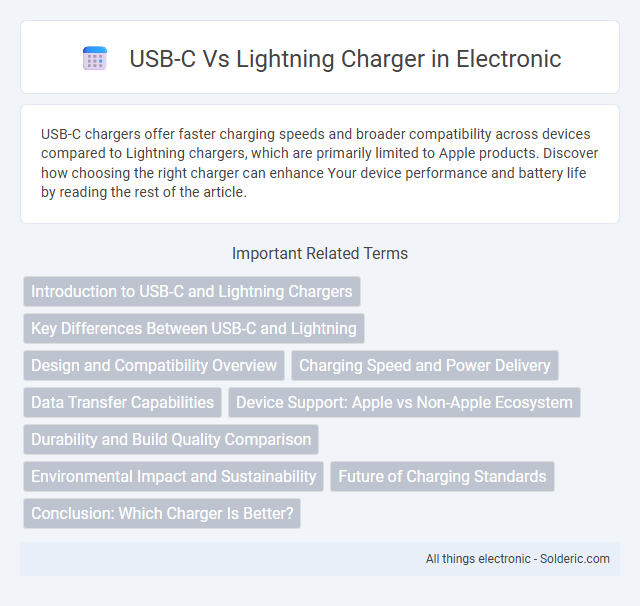USB-C chargers offer faster charging speeds and broader compatibility across devices compared to Lightning chargers, which are primarily limited to Apple products. Discover how choosing the right charger can enhance Your device performance and battery life by reading the rest of the article.
Comparison Table
| Feature | USB-C | Lightning |
|---|---|---|
| Connector Type | Reversible, Oval-shaped | Proprietary, Reversible |
| Data Transfer Speed | Up to 40 Gbps (USB4/Thunderbolt 3) | Up to 480 Mbps (USB 2.0 standard) |
| Charging Power | Up to 100W (Power Delivery) | Up to 20W |
| Compatibility | Wide adoption: smartphones, laptops, tablets | Apple devices only (iPhone, iPad, iPod) |
| Durability | Robust metal connector, longer lifespan | Plastic and metal, moderate lifespan |
| Universal Standard | Yes (USB Implementers Forum) | No, proprietary Apple standard |
| Video Support | Yes (DisplayPort Alt Mode) | No native video support |
Introduction to USB-C and Lightning Chargers
USB-C and Lightning chargers represent two key standards in device connectivity and charging technology, with USB-C providing a universal solution compatible with many smartphones, tablets, and laptops, while Lightning remains exclusive to Apple products. USB-C supports faster data transfer rates up to 10 Gbps and higher power delivery, enhancing charging efficiency and versatility. Your choice between these chargers depends on device compatibility, charging speed requirements, and ecosystem preferences.
Key Differences Between USB-C and Lightning
USB-C chargers feature a universal 24-pin connector compatible with a broad range of devices, supporting faster data transfer rates up to 10 Gbps and power delivery up to 100W. Lightning connectors, proprietary to Apple, have an 8-pin reversible design optimized for Apple devices, offering data transfer speeds up to USB 2.0 standards (480 Mbps) and lower power delivery compared to USB-C. USB-C's widespread adoption facilitates cross-device compatibility, while Lightning remains exclusive to Apple's ecosystem, impacting accessory interoperability.
Design and Compatibility Overview
USB-C chargers feature a reversible, oval connector designed for universal compatibility across multiple devices, including smartphones, tablets, laptops, and accessories from various manufacturers. Lightning chargers, proprietary to Apple, have a smaller, reversible design specifically optimized for iPhones, iPads, and select Apple peripherals, ensuring seamless integration within the Apple ecosystem. Your choice between USB-C and Lightning will impact device compatibility, charging speed, and accessory availability.
Charging Speed and Power Delivery
USB-C chargers support higher power delivery standards, often reaching up to 100 watts, which enables faster charging speeds for compatible devices compared to Lightning chargers that typically max out around 12 to 18 watts. Power Delivery (PD) technology integrated into USB-C allows dynamic adjustment of voltage and current, optimizing charging efficiency and reducing overall charge time. Lightning chargers rely on Apple's proprietary charging protocols that limit peak power output, resulting in slower charging speeds compared to the more versatile and widely adopted USB-C PD standard.
Data Transfer Capabilities
USB-C supports significantly faster data transfer rates, with Thunderbolt 3 and USB 3.2 Gen 2x2 enabling speeds up to 40 Gbps and 20 Gbps respectively, far surpassing Lightning's maximum throughput of 480 Mbps via USB 2.0 protocols. This enhanced capability allows USB-C to handle large file transfers, high-resolution video streaming, and rapid device synchronization efficiently. Lightning's slower data transfer limits its performance primarily to basic charging and modest data sync tasks.
Device Support: Apple vs Non-Apple Ecosystem
USB-C chargers provide broad compatibility across non-Apple devices including Android smartphones, tablets, laptops, and various peripherals, making them a versatile choice for users with diverse gadget ecosystems. Lightning chargers are exclusive to Apple devices like iPhones, iPads, and certain accessories, limiting their use to the Apple ecosystem but offering optimized performance and seamless integration. The growing industry shift towards USB-C reflects increasing support beyond Apple, driven by universal standards for faster charging and data transfer across multiple platforms.
Durability and Build Quality Comparison
USB-C chargers typically offer superior durability and build quality due to reinforced connectors and flexible, high-grade cables designed to withstand frequent bending and plugging. Lightning connectors, while compact and proprietary to Apple devices, tend to show wear more quickly because of thinner cable insulation and less robust connector pins. Your choice between USB-C and Lightning should consider longevity needs, especially if you rely on daily charging and portability.
Environmental Impact and Sustainability
USB-C chargers promote environmental sustainability by supporting universal compatibility, reducing electronic waste from multiple cables and adapters, unlike proprietary Lightning connectors used exclusively by Apple products. USB-C's broader adoption enables efficient resource use through standardization, minimizing the carbon footprint linked to manufacturing and disposal processes. The durability and faster charging capabilities of USB-C also contribute to longer device lifecycles, further enhancing eco-friendly technology practices.
Future of Charging Standards
USB-C is becoming the global standard for charging due to its faster data transfer rates, higher power delivery, and wide adoption across numerous devices, including laptops, tablets, and smartphones. Lightning connectors, primarily used by Apple, face potential obsolescence as regulatory bodies push for universal USB-C adoption to reduce electronic waste and enhance interoperability. Transitioning to USB-C would future-proof Your devices, ensuring compatibility and improved charging efficiency across evolving tech ecosystems.
Conclusion: Which Charger Is Better?
The USB-C charger offers faster charging speeds and broader compatibility across devices, making it a more versatile option compared to the Lightning charger, which remains limited to Apple products. Your choice depends on your device ecosystem, but USB-C's widespread adoption and future-proof design provide greater convenience and efficiency. For users seeking universal use and faster power delivery, USB-C is generally the better charger.
USB-C vs Lightning charger Infographic

 solderic.com
solderic.com